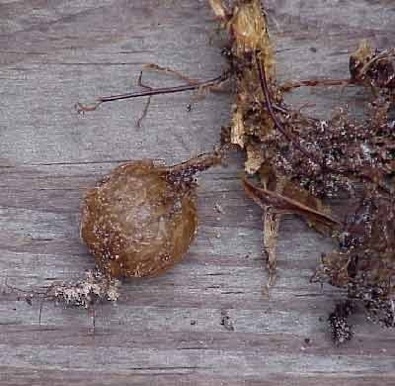Nephrolepis cordifolia: Edible Watery Stolons
Edibles are often right under your feet, or my feet as it were.
I had a yard of non-edible ferns. If you like fiddleheads that’s an irritation. That irritation in time lead me to buying a regional fern book to seek out more fiddleheads than I already knew. To make sure I could ID ferns well I started with the ones in my yard, Nephrolepis cordifolia. From the other side of the world they were first found growing in Florida beside a road in Sumter County in 1933. They have since covered much of the state.
As the N. cordifolia does not produce much of a fiddlehead I ignored it for some eight years as it spread, covering half my property. The identification was rather easy in that of the five Nephrolepis in the state the cordifolia is the only one with marble-size stolons growing off its roots. In fact when I wanted to move ferns to a new spot I often planted the stolons. I thought nothing of them.
My research led me to a scientific paper on the plant from Nepal, Nutrient Analysis of Nephrolepsis, Kathmandu University Journal of Science, Engineering and Technology, Vol 4, No 1 (2008). A team not only tested the Nephrolepis cordifolia for nutritional content but reported children there eat the stolons raw all the time, apparently their favorite wild snack. The team recommended the stolonss be investigated as a potential commercial crop. After rechecking my plants I suddenly realized I had thousands of ferns with edible stolons.
This was a win win in disguise. Florida put the N. cordifolia on the state’s plant pest list, the only fern of about 100 to make it. The state doesn’t like it because the fern is squeezing out the native Nephrolepis exaltata, which is a commercial product. While many ferns species have useable rhizomes only two Nephrolepis have swolen stolons and both are edible, N. cordifolia and N. undulata. What that means is if you have a Nephrolepis and it hasstolons you have an edible. If you don’t live in pan-tropical regions around the world, no problem. There is probably a pot of sword ferns in any number of businesses and lobbies near you. Gently pull the fern root mass out of the pot and look for stolons. If it is a sword fern (Nephrolepis) and it has stolonss, it is edible. Often the N. cordifolia is sold as the N. exaltata because folks don’t know the difference. So you could have fern stolons near you.
Research on the Nephrolepis can be confusing. While online references say there are about 30 species of Nephrolepis in the world a recent study suggests 19 or so, read some consolidation and parsing happened. There still may be some future sorting out in that not all agree there are 19 species. A Florida botanist is quoted on a site as saying there are four species of Nephrolepis with stolons. I contacted him and he flatly denies ever writing or saying any such thing. That is why contacting primary sources is important. The Internet is just a place to start your research. It is not the place to end it.
Nutritionally the stolons of the N. cordifolia are 13.42 percent carbohydrates, 1.34% protein, 1.25 percent starch, 14.88 percent crude fiber, 6.53 ash, 0.75 percent calcium and trace phosphorus. They’re also about 96% water. They can range in color from cream to yellow to dark tan or brown. To me they taste similar Jerusalem Artichokes with the same crunch, a varying amount of astringency, water and potato-like earthy aroma. From the plant’s point of view the tubers are for water storage. The fern is often an epiphyte growing on other plants, most noticeably on palm trees. The stolons can provide water for the dry spells.
Nephrolepis (nef-roh-LEP-iss) is Greek and means kidney shaped scales, referring to the shape of the spoor packets on the back of the fern’s leaf. Cordifolia (kor-di-FOH-lee-uh) means heart-leaf. Where each leaf (pinnule) attaches to the stem (rachis) there is a little protrusion that looks like the bottom of a heart. Identifying ferns is often nearly microscopic in nature. You definitely need a hand lens at least 10x and a lot of patients. The plant is native to Australia and the Himalaya areas. It is found in the Society Islands, New Zealand, Puerto Rico, Hawaii, Florida, Georgia, Alabama, and protected pots elsewhere. If you have a “Boston Fern” in might be the N. cordifolia. Look for the stolons. See my video on said.
Other ferns species with reportedly edible tubers include Angiopteris evecta, Diplazium esculentum, Cyathea medullaris, Pteris esculenta, Gleichenia dichotoma, and Marattia alata. Pteris aquilinum and Aspidium filix tubers have been used to make beer. Tubers are usulally starche and much larger than stolons.
Green Deane’s “Itemized” Plant Profile
IDENTIFICATION: A medium-sized, medium-green, Boston/sword Fern, tapering to both ends, producing below ground scaly round stolons. Leaves pinnate, fertile and sterile fronds similar to three feet long and three inches wide; petioles to eight inches long, Forty to 100 leaflets on each side, oblong-lanceolate with a heart shaped lobe stem end of leaf; leaflet entire to slightly toothed, underside spore packets kidney-shaped
TIME OF YEAR: Tubers are available year round. The plant produces a horizontal root (rhizome.) Off the rhizome are wiry roots, stolons. Growing on the stolons will be the fuzzy hairs. I think calling them “tubers” is not exactly correct, more like water storage units, swolon stolons.
ENVIRONMENT: Shady areas, lawns, waste ground, limestone ledges, wet places, roadsides, in palm trees.
METHOD OF PREPARATION: Eaten raw, out of hand. If you roast large ones in a slow oven the turn into sweet, chewy lumps. Small ones keep their shape but turn to a powder inside that tastes like coffee.



